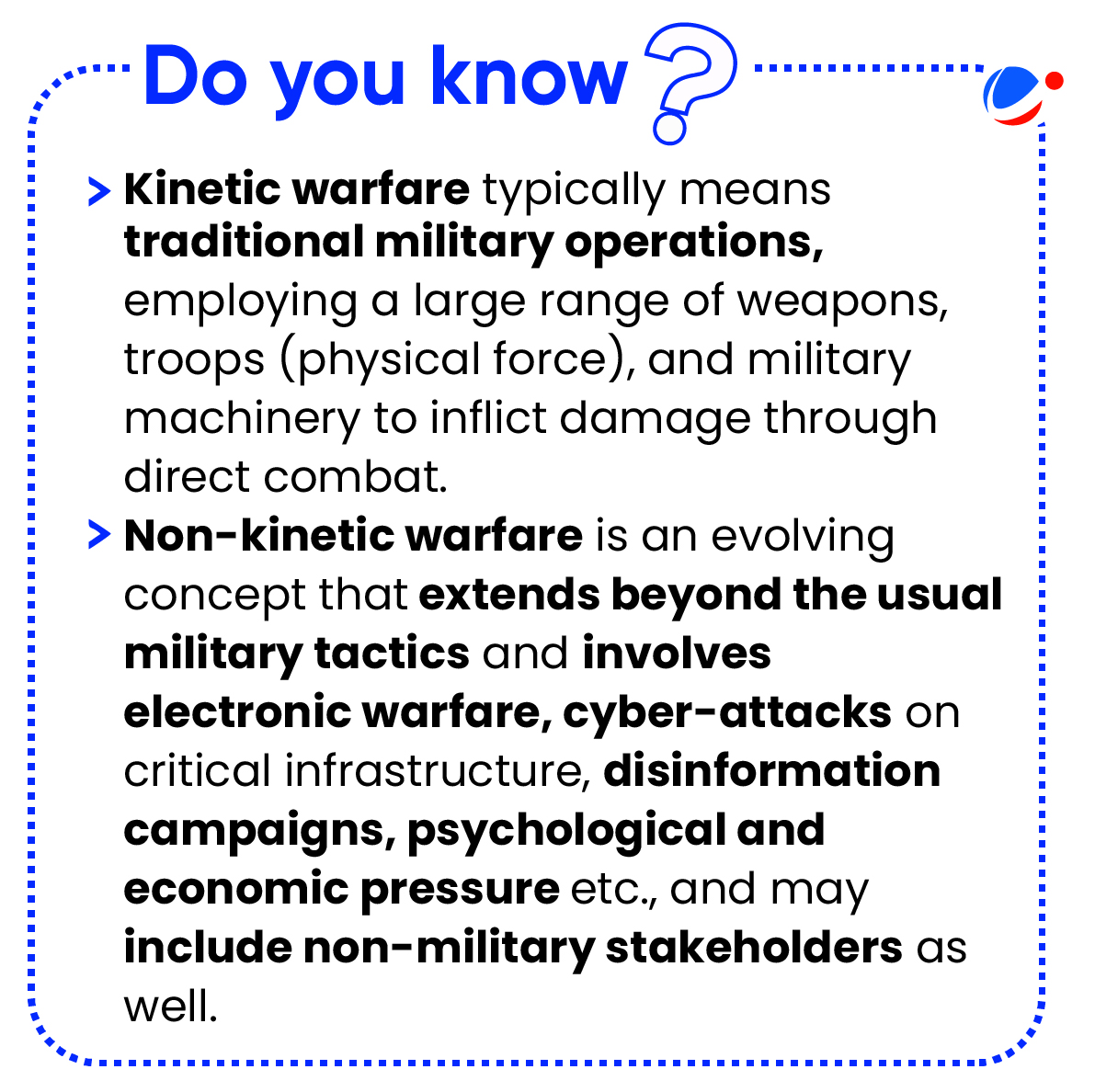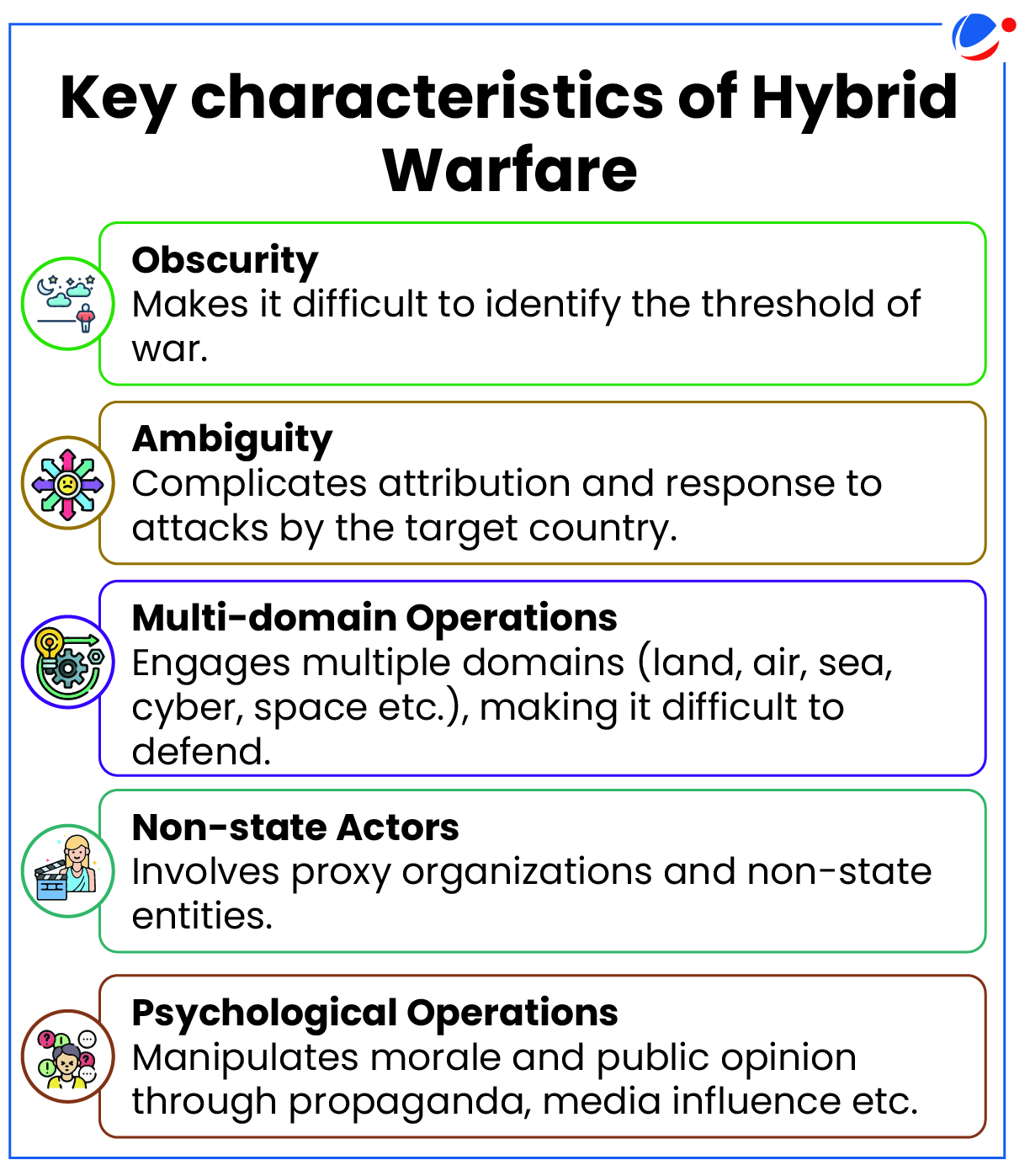Why in the news?
Recently, Union Defence Minister underlined the dangers of hybrid warfare to India.
More on the news
- Defence Minister highlighted the growing overlap/ blurring line between border security and internal security, emphasizing that hybrid warfare can threaten critical national infrastructure.

- He noted that, traditional concept of frontline is rapidly changing, with threats such as terrorism, extremism, cyber warfare or cyber-attack, human trafficking or humanitarian crises etc., transcend national borders and challenges the established notions of India's internal security.
About Hybrid Warfare
- Definition: Hybrid warfare, also known as asymmetric warfare, is a strategy that combines conventional tactics (kinetic warfare) with unconventional methods (non-kinetic warfare), often employed to achieve political or strategic goals without resorting to full-scale war.
- Examples:
- China's three warfare strategy including psychological, political and legal tactics;
- Use of cyberattacks, disinformation and propaganda witnessed during Russia-Ukraine conflict;
- Psychological and information warfare tactics seen in Israel-Palestine conflict;
- Pager blasts as a form of disruption in Lebanon etc.
Reasons for emergence of hybrid warfare

- Strategic advantage: Helps achieve political, military or economic objectives without any declaration of war keeping the possibility of diplomatic negotiations open.
- E.g., Use of 'little green men' (unmarked soldiers) is a hallmark of Russia's approach to hybrid warfare, providing strategic advantage to achieve its political and military objectives while minimizing the risk of direct confrontation with other states.
- Cost effectiveness: It evades direct responsibility, and is logistically and economically less costly and complex.
- E.g., U.S. uses a range of policy tools intended to reduce threats posed by Iran, including economic sanctions, which restrict former's financial and military spending without deploying troops or engaging in direct combat.
- Technological advancement: Rise of cyber capabilities, artificial intelligence, digital communication tools etc., has enabled non-traditional methods of warfare, such as cyberattacks and disinformation campaigns etc., without direct military confrontation.
- E.g., Russian cyber-attacks against Ukraine have persisted ever since Russia's illegal annexation of Crimea in 2014, intensifying just before the 2022 invasion.
- Rise of non-state actors and proxy warfare: Traditional warfare has become less frequent, while conflicts involving state and non-state actors (terrorist groups, militias, cyber warriors, etc.) have increased, engaging in a complex web of alliances, proxy support, information warfare and vile tactics to achieve their strategic objectives, while maintaining deniability.
- E.g., Iran's support for Houthi rebels in Yemen through arms smuggling.
- Global interconnectivity: Economic interdependence and internet, accelerated hybrid warfare by allowing adversaries to exploit cyberspace, manipulate through economic coercion (sanctions, trade restrictions etc.), spread propaganda through media (election interference) etc., destabilizing nations, without engaging in open conflict.
- E.g., alleged Russian interference in the 2016 U.S. elections using social media bots.
Hybrid warfare threats to India
- Hostile neighbours and non-state actors: E.g., Pakistan has been a master in hybrid warfare and its support for proxy war, terrorist organisations, and counterfeit currency threatens India's security.
- External threats: E.g., China specializes in Grey Zone strategies and has been winning wars without fighting to meet its global aspirations.
- Internal insurgencies: E.g., Left Wing Extremism (Naxalism) challenges in central India, ethnic conflicts in northeast, etc.
- Threat to critical infrastructure: E.g. cyberattacks on the Kudankulam Nuclear Power Plant in 2019; alleged Chinese malware attack on Mumbai grid in 2020 etc.
- Economic warfare: E.g., significant Chinese imports of electronic goods, APIs (pharmaceutical ingredients) etc., makes India vulnerable to supply chain disruptions.
India's preparedness towards hybrid warfare
- Modernization of defence capabilities: E.g., developing advanced weapons under 'Directionally Unrestricted Ray-Gun Array (DURGA)-II Project' (Initiated by DRDO), defence indigenization through 'Make in India' initiatives etc.
- Structural reforms and establishing institutions: E.g., military integration through creation of Chief of Defence Staff (CDS), Defence AI Project Agency (DAIPA), Defence AI Council (DAIC), etc.
- Counter cyber security measures: E.g., operationalization of Defence Cyber Agency in 2021 to specifically address cyber threats to national security.
- International partnerships: E.g. Cooperation through General Security of Military Information Agreement (GSOMIA) with USA, working with Quad (Quadrilateral Security Dialogue) framework to address issues like cyber security etc.
- Parliamentary reviews: Indian armed forces' preparedness to deal with hybrid warfare is one of the subjects that the Parliamentary Standing Committee on Defence (2024) has narrowed down for deliberation.
- It will assess areas like cyber defence, anti-drone technologies, integration of advanced systems to address evolving threats etc.
Way forward
- Capacity building: Indian defence forces and security apparatus needs to build experts, systems and doctrines in multiple domains to tackle future hybrid challenges.
- E.g., building resilience of armed personals to handle advanced technologies; develop capabilities for cyber retaliation and offensive cyber operations etc.
- Integrate hybrid warfare into adaptive defence strategies: E.g., creation of a division dedicated to hybrid warfare with both offensive and defensive abilities, which should form an integral part of national security strategy.
- Adopting proactive approach instead of reactive: Using smart power and establishing a set of response options using all available tools, such as diplomatic (Track-II channels), economic, informational, infrastructural, politico-military coordination etc.
- 'Whole of government' approach: E.g., a coordinated 'grand plan' encompassing all ministries, designed by National Security Council Secretariat under the direction of the National Security Advisor and with the consent of the Cabinet Committee on Security, can be used to address hybrid warfare risks.



